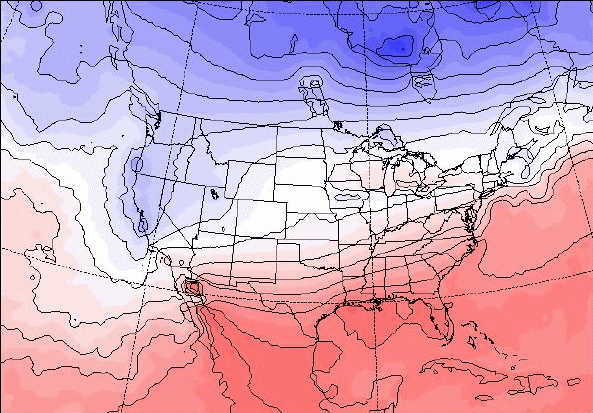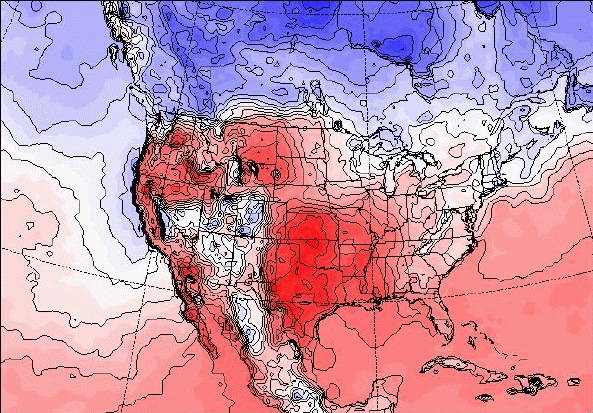A note about sea-surface temperatures and skin temperatures
The way sea-surface temperatures are archived seems to vary widely
from dataset to dataset. In REGRID parlance, we make a distinction
between sea-surface temperature and skin temperature.
A sea-surface temperature field represents the temperature
of the water (whether that's the temperature at the water
surface or temperature of some layer at the top of the water).
Over land, this field doesn't really have any meaning, and in
many datasets the values are smoothly interpolated from water
points. Example:
 . .
A skin temperature field represents
the temperature of the surface of the earth, whether that surface
is land or water. Thus, in summer for example, you may wind up
with large temperature gradients between warm land points and
cold water points. Example:

The skin temperature can be tricky to use within the MM5 modeling
system, because of the horizontal interpolation to the MM5 grid.
Horizontal interpolation to a point near the coast can wind up
being an interpolation from a land point and a water point. If,
for example, the summertime ground temperature is considerably
warmer than the water temperature, you may wind up with unreasonably
cold ground temperatures and unreasonably warm water temperatures
at the coast. This will be particularly noticeable when interpolating
to an MM5 grid that has a much higher horizontal resolution that
the source dataset.
At the REGRID stage, fields SST and SKINTEMP are treated identically.
They are simply interpolated to the MM5 horizontal grid, with
no concern for what may happen at the coast.
Later in the MM5 modeling system, in program INTERPF, fields called
SST and SKINTEMP are interpreted differently. If an SST field
is found, INTERPF will interpret that field as one that can be
used as an instantaneous field appropriate for water temperatures,
which may vary in time. INTERPF will create a lower-boundary-conditions
file (LOWBDY) with an SST field for each analysis time. This field
will be called TSEASFC. If there is no SST field, but a SKINTEMP
field is found, INTERPF will average SKINTEMP for all times, and
write that average as a single, time-invariant TSEASFC field to
the LOWBDY file. This averaging is done to remove the diurnal
variation of the skin temperature over land in the averaged, time-invariant
TSEASFC field.
In short, fields called SST will be interpreted as instantaneous
water-temperature fields and will allow time-varying sea-surface
temperatures
|

 .
. 